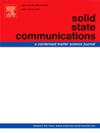增强alfeo3修饰Bi1/2Na1/2TiO3材料的光学和磁性能
IF 2.1
4区 物理与天体物理
Q3 PHYSICS, CONDENSED MATTER
引用次数: 0
摘要
本研究采用溶胶-凝胶法制备了(1-x)Bi1/2Na1/2TiO3+xAlFeO3固溶体。x射线衍射和拉曼散射分析表明,所有样品都保持了菱形结构的对称性,在固溶体形成过程中,Al和Fe阳离子随机融入到Bi1/2Na1/2TiO3晶格中。这种掺入引起了晶格畸变,将纯Bi1/2Na1/2TiO3的光学带隙从3.07 eV减小到含有9mol .% AlFeO3的样品的2.64 eV。此外,与纯Bi1/2Na1/2TiO3相比,(1-x)B1/2Na1/2TiO3+xAlFeO3体系的磁性能显著增强。这些发现为未来技术应用的多功能无铅材料的开发提供了有价值的见解。本文章由计算机程序翻译,如有差异,请以英文原文为准。
Enhancing optical and magnetic properties of AlFeO3-modified Bi1/2Na1/2TiO3 materials
In this study, solid solutions of (1-x)Bi1/2Na1/2TiO3+xAlFeO3 were successfully synthesized using the sol-gel method. X-ray diffraction and Raman scattering analyses revealed that all samples maintained rhombohedral structural symmetry, with Al and Fe cations randomly incorporated into the Bi1/2Na1/2TiO3 lattice during solid solution formation. This incorporation induced lattice distortions and reduced the optical band gap from 3.07 eV for pure Bi1/2Na1/2TiO3 to 2.64 eV for the sample containing 9 mol.% AlFeO3. Additionally, significant enhancements in magnetic properties were observed in the (1-x)B1/2Na1/2TiO3+xAlFeO3 system compared to pure Bi1/2Na1/2TiO3. These findings offer valuable insights into the development of multifunctional lead-free materials for future technological applications.
求助全文
通过发布文献求助,成功后即可免费获取论文全文。
去求助
来源期刊

Solid State Communications
物理-物理:凝聚态物理
CiteScore
3.40
自引率
4.80%
发文量
287
审稿时长
51 days
期刊介绍:
Solid State Communications is an international medium for the publication of short communications and original research articles on significant developments in condensed matter science, giving scientists immediate access to important, recently completed work. The journal publishes original experimental and theoretical research on the physical and chemical properties of solids and other condensed systems and also on their preparation. The submission of manuscripts reporting research on the basic physics of materials science and devices, as well as of state-of-the-art microstructures and nanostructures, is encouraged.
A coherent quantitative treatment emphasizing new physics is expected rather than a simple accumulation of experimental data. Consistent with these aims, the short communications should be kept concise and short, usually not longer than six printed pages. The number of figures and tables should also be kept to a minimum. Solid State Communications now also welcomes original research articles without length restrictions.
The Fast-Track section of Solid State Communications is the venue for very rapid publication of short communications on significant developments in condensed matter science. The goal is to offer the broad condensed matter community quick and immediate access to publish recently completed papers in research areas that are rapidly evolving and in which there are developments with great potential impact.
 求助内容:
求助内容: 应助结果提醒方式:
应助结果提醒方式:


